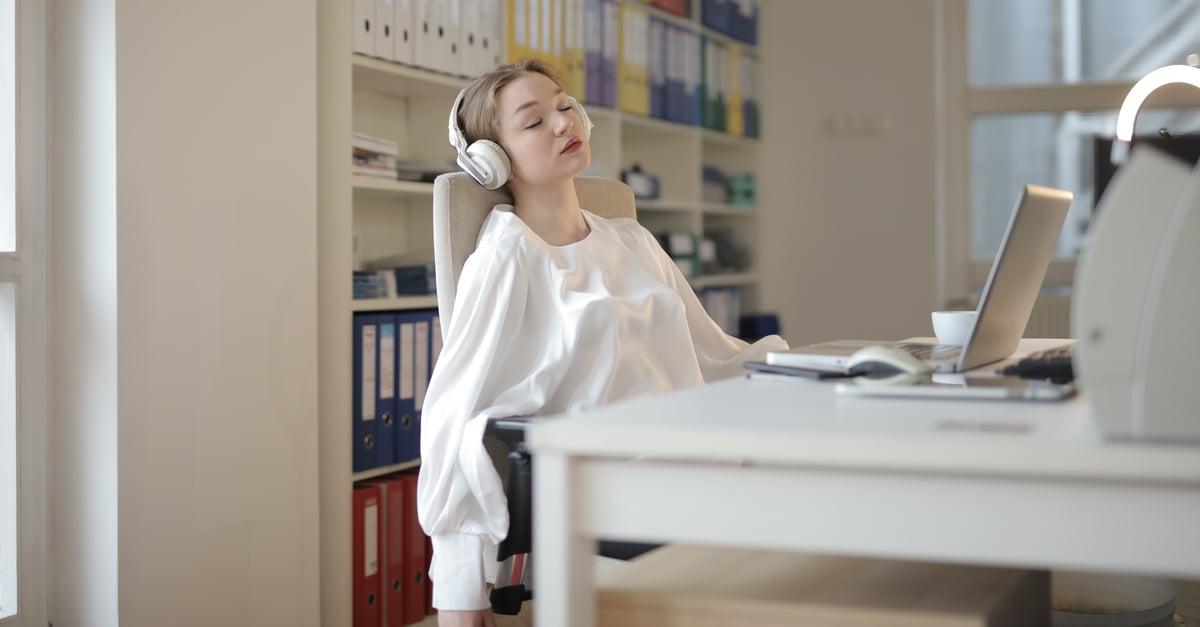
Digital eye strain is a 21st-century problem. As technology allows businesses to remain agile and improve collaboration, it comes as no surprise that office workers have increasingly relied on computers to get their tasks done right away. But at what cost?
Eye Strain in the Office
Let’s walk through our usual day at work. Whether working from home or at an office, we start our mornings by checking our phones and replying to important messages. Because our phones are just within arm’s reach, it is easy to turn them on as we’re making breakfast, drinking our coffee, or preparing our things for the day. When we clock in for work, we switch our personal computers or laptops on and start our 9 to 5 job. Getting up for lunch, many of us are guilty of watching videos or reading articles on our phones while we eat. Even as we sign off from work, we go on a streaming site and watch our favourite show or scroll through our social media feed.
Without even realizing it, we have started and ended our day with our eyes glued to a screen, whether it was for work or recreational activities. By the end of it, our eyes feel tired and heavy.
With prolonged exposure to our bright screens, we become likely to experience health disorders associated with prolonged computer use, such as eye and vision problems. While these different issues are considered temporary, they are a great discomfort and can hinder you from accomplishing your tasks at work.
The truth of the matter is that the human eye is not designed for looking at our computer screens for long hours. Before the digital 21st century, office work included typing, reading, writing, and filing, all of which require different movements and visual demands. The combination of these activities is used to reduce the workforce’ chances of eye strain. As computers allow us to perform these tasks from one place, our eyes don’t have the opportunity to rest.
Symptoms and Causes of Computer Vision Syndrome
Working on your computer is more demanding on your eyes than any other type of office work. Just imagine looking at a report from your computer and comparing it to its printed version. You will see that your eyes are less strained when looking at a piece of paper.
Unlike printed text or images, everything on your screen is a collection of tiny pixels of light. You will also find that, after a few minutes, your eyes will unconsciously try to rest by shifting your focus to a point outside your screen. Because of this, your eyes have to constantly refocus back to your screen, causing exhaustion and strain.
As we are in the middle of a pandemic, we need to prioritize taking care of our health and placing ourselves in a healing environment. Computer vision syndrome has several symptoms that office workers need to be on the lookout for.
- Blurry Vision
You might have caught yourself staring at an image or text for too long until your eyes have blurred the details out. People who suffer from computer vision syndrome sometimes experience this from overexposure and prolonged focus. If your workplace is also a stressful environment, your eyes respond to the high levels of adrenaline by dilating your pupils and allowing more light in. While this should help your eyes find the source of your distress, your heightened blood pressure can also cause your eyes to blur. In other cases, people with undiagnosed eye problems or improper prescription glasses can also experience blurry vision. - Headaches
Research shows that there is a link between computer vision syndrome and exposure to blue light from the television, computer and phone screens and televisions. This can lead office workers to experience headaches. In addition to blue lightwaves, bright screens and high contrast can also affect your eyesight and trigger headaches. This is especially true for people who have photophobia or extreme light sensitivity. - Strained Eyes
Compared to blurry vision, your eyes become strained when you don’t pause to rest them. Just like driving for long distances or watching a four-hour-long movie, staring at our digital screens for two or more hours can also tire our eyes out. - Dry Eyes
Your eyes are made up of millions of living cells that can die if they are not kept moist. Your tears do not only appear when you cry. Your eye hydration helps wash away debris, prevent infection and keep your vision clear. Studies show that when people stare at their computers, they are less likely to blink as many times as they normally do. Your condition usually worsens when you’re also exposed to a fan or an air-conditioning system. - Neck and Shoulder Pain
Computer vision syndrome extends until the base of your head. When your computer is placed at the wrong angle, you’re straining your whole head to look at your screen properly.
While these symptoms can be uncomfortable, they are only temporary. Because headaches and neck and shoulder pain can easily be linked to other illnesses or sickness, we recommend that you see your eye doctor before making drastic changes to your lifestyle in the face of a severe symptom.
Office Ergonomics and Eye Health: Preventing Vision Problems Related to Computer Use
We encourage everyone to take a comprehensive eye examination to determine their visual requirements when using your computer or gadgets. An ophthalmologist will measure your visual acuity and check for any refractive errors. Doing this can address any pre-existing conditions you may not know to exist.
While our screens can cause our eyes to hurt and dry up, we should take a step back and see if our work environment serves its purpose. With office ergonomics, we look at how your workstation can assist your capabilities and support your limitations.
Your goal is to create a comfortable space where you can work properly and efficiently, preventing fatigue and overall discomfort.
- Add Comfortable Seating
Your eyes are a part of a whole. To holistically address your computer vision syndrome, you need to take care of the rest of your body. First, properly position your body when using your computer. We recommend using seats that are comfortably padded but still support your body’s posture.
Your chair height should be adjusted so that your feet rest flat on the floor, instead of it dangling from the edge of your seat. This will keep your leg muscles and veins relaxed throughout your workday. In addition, make sure that your back is relaxed.
The optimal way to view your computer is by positioning your screen 15 to 20 degrees or about 4 to 5 inches below eye level. We also recommend keeping your eyes 20 to 28 inches away from your screen, with the monitor slightly tilted back. A good way to start is by placing it within arm’s length. All of these efforts should help your head and neck while you’re working.
Next, if your computer is too close to the edge of your table, consider pushing it back to give space for your forearms to rest. Not only does this prevent carpal tunnel, but your body is no longer straining forward just to use the keyboard or the mouse properly.
This is also where your desk’s ergonomics comes in. The standard desk height is between 29 to 30 inches tall. If you think that it is too high for you, we recommend using a keyboard tray to position your keyboard and mouse at the correct height. This allows your wrists and forearms to relax without your shoulders tensing up.
- Adjust Lighting
Many offices and homes have more light installed than what is required for computer use. We recommend having moderate, indirect lighting to avoid glaring light.
When talking about light sources, there are three types:
Direct Glare: Imagine getting up in the morning and looking out your bedroom window that faces the rising sun. Direct glare happens when light shines directly into your eyes. When you’re working, this normally happens when you’re facing a window or, in some cases, when your desk lamp disrupts your vision.
Indirect Glare: When light sources bounce off an object and hit your eyes, you’re seeing an indirect glare. When this happens, you normally see your reflection on the monitor or white spots. If you’re not sure if your screen is reflecting glare, you can turn your monitor off and examine any reflections on it.
Contrast Glare: The most frequently overlooked type of glare is when a light-coloured object is positioned next to a dark object. For example, your screen may be bright coloured while your monitor borders are dark. As you try to focus on the screen, your retina is trying to become larger to absorb more light to focus on the dark object and become smaller to absorb less light to see the light object. As a result, you’re straining your eyes just by looking at your screen.
If you notice that your computer screen reflects outdoor or fluorescent lights, we recommend moving your monitor someplace else. If you don’t have enough space to move around, you may use a glare screen to reduce the light reflected into your eyes. You may also opt for privacy screens, where other people are not able to see your screen as you’re using it.
If your monitor is not at risk of reflecting glare, you can also let natural light in and turn off your fluorescent lights. As natural light isn’t harsh on the eyes compared to LED or fluorescent ones, your eyes have more opportunity to rest and make you less likely to feel sleepy throughout the day. If you work in an office and are not able to have your lights replaced, you can bring a smaller lamp that emits a light that is similar to natural lighting outside. This is especially helpful if you work during a graveyard shift and need to stay awake.
- Optimize Computer Screen
Aside from adjusting your environment, you can also play with your monitor’s brightness settings to see what level doesn’t strain your eyes, finding the sweet spot where it is neither too bright nor too dark. You can also change the screen contrast or make the text’s default size larger. - Use Prescription Glasses
You may already have pre-existing eye conditions and are not using your prescription glasses. We recommend using them, especially as you’re more likely to damage your eyes when you use a monitor than when you go for a drive, read a book or visit an art gallery. Reduce your vision stress on the job and improve your eye health in the process, getting your eyes checked every year.
One common myth we hear is that wearing prescription glasses only worsen your eyesight. On the contrary, foregoing your glasses can strain your eyes further.
- Practice Proper Rest
As we’re less likely to blink while staring at our computer screens, make it a point to blink every few seconds to keep your eyes moist and hydrated. If you’re more prone to dry eyes, we also recommend bringing eye drops to avoid irritation.
When you start to feel your eyes drifting away from your screen to rest, it’s time to take a break. Instead of picking up your phone to scroll through social media, we recommend getting up and looking for an alternative activity. You can do a few stretches that relax your back and wrists, take a short walk outside, or walk to your pantry or kitchen for a quick water break.
During these ten to fifteen-minute breaks, you’re allowing your eyes a slight reprieve before returning to work. If you’re at the office, you can make a few phone calls or make a short trip to the photocopy machine.
Another alternative is taking a nap with Wellcare’s 4D DWF heating pad on your shoulder and neck to reduce your exhaustion. When your body is tired, your eyes could also be sore. Ultimately, taking time to rest your eyes from a few hours of work can prevent any severe digital eye strain symptoms.
So next time when you are tried, try closing your eyes for few minutes and take a relaxing break with Wellcare's unique 4D DWF heating pad. You will feel more rejuvenated after a quick break and feel ready for work.
One thing to note is that if your eyes feel tired but you try to ignore it, you might be putting more strain on your muscle and fascia. This will make you feel your body is heavy and even more tired.
Wellcare's products are equipped with the 4D Dynamic Warmth Flow system (4D DWF). Innovation in electric heating technology, the 4D DWF mimics the human body’s breathing to ensure even heat distribution throughout the surface of the product. This unique technology will help you relax and get a good nap or night of sleep.
From heating pads, heating cushions, foot warmers to electric blankets, Wellcare has a wide range of solutions to help you sleep better and keep your feet warm at all times. For your complete warmth, comfort, and safety, these are made using only the finest available materials.
Interested in learning about our unique product? Looking to buy one immediately? Click on the link below to visit our store.



.png?width=512&name=united-kingdom%20(1).png)
